Diocese Documents 50 Year Impact on the Community
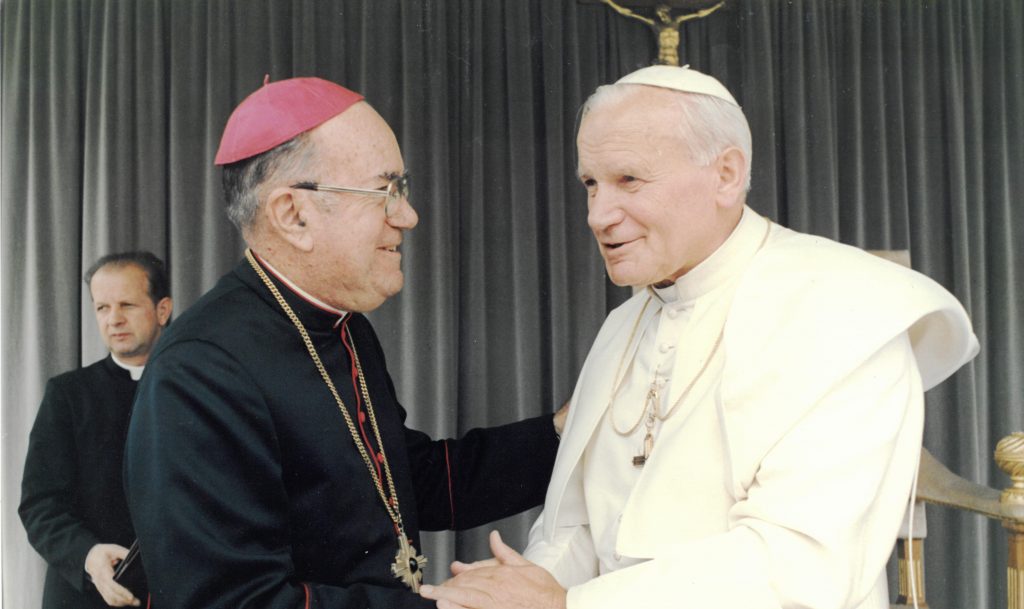
50 Years of Caring for the Community
On June 17, 2018, the Diocese of St. Petersburg will celebrate the 50th anniversary of its establishment. Bishop Gregory Parkes has chosen the theme of “Gratitude, Joy and Hope” for the Diocese’s golden jubilee. He is asking all Catholics to remember the past with gratitude, celebrate the present with joy and look to the future with hope. In this document, we recall the past 50 years with gratitude, recalling the impact we, as a people of faith, have made in this community we call home. (Photo above shows Bishop W. Thomas Larkin meeting with Pope John Paul II in 1979.)
IMPACT ON THE COMMUNITY (PDF available here.)
Every day, the Diocese of St. Petersburg ventures outside church walls to serve people in need, regardless of their religious affiliation. In fact, 75% of people served by Catholic Charities are not Catholic. Many parishes in our diocese have outreach programs, such as the St. Vincent de Paul Society, that serve the poor, hurting and suffering and many also support community-based programs. Twelve parishes currently have “twinning” relationships with churches in third world countries, such as the Dominican Republic, Haiti, and Cuba, to provide financial and human support. Through our charitable efforts, we have positively impacted the lives of many families and individuals. While some of the impact cannot be quantified, below is an overview of some of the ways we have had a positive impact on life in West Central Florida and Tampa Bay over the past 50 years.
IMPACT ON PRIESTHOOD
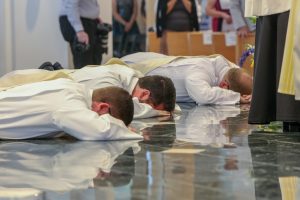 For many of the early years, the Catholic Church in Florida relied on missionary priests from the Northeast, Ireland and Spain. Since its founding, 123 priests have been ordained to serve the people of God in the Diocese of St. Petersburg and there has been an intentional effort to foster the development of local vocations. Recent examples of homegrown priests are Father Kyle Bell, Father Lou Turcotte, and Father Tim Williford. They were all raised in the Tampa Bay area and on May 19, 2018, they were ordained as new priests for the Diocese of St. Petersburg by Bishop Gregory Parkes.
For many of the early years, the Catholic Church in Florida relied on missionary priests from the Northeast, Ireland and Spain. Since its founding, 123 priests have been ordained to serve the people of God in the Diocese of St. Petersburg and there has been an intentional effort to foster the development of local vocations. Recent examples of homegrown priests are Father Kyle Bell, Father Lou Turcotte, and Father Tim Williford. They were all raised in the Tampa Bay area and on May 19, 2018, they were ordained as new priests for the Diocese of St. Petersburg by Bishop Gregory Parkes.
IMPACT ON WORKERS
In 1969, after sanitation workers began to strike to protest unfair treatment, Bishop Charles McLaughlin helped to form Religious United in Action for Community (RUAC) and was elected the first chairman. The goal was to help workers have better working conditions and to “unite in expression of our concern for the moral and physical welfare of all citizens.”
IMPACT ON RADIO
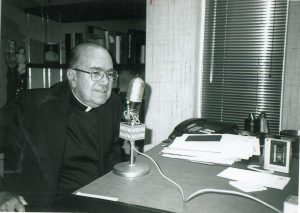 In 1986, Bishop Larkin established WBVM 90.5, a radio station that serves the community with the largest signal allowed by the FCC: 100,000 watts. The station, now known as Spirit FM 90.5, provides hopeful and positive music, inspiring messages, weather alerts, community and event information to people of all faiths. Spirit FM currently reaches approximately 100,000 people each week.
In 1986, Bishop Larkin established WBVM 90.5, a radio station that serves the community with the largest signal allowed by the FCC: 100,000 watts. The station, now known as Spirit FM 90.5, provides hopeful and positive music, inspiring messages, weather alerts, community and event information to people of all faiths. Spirit FM currently reaches approximately 100,000 people each week.
IMPACT ON RACE RELATIONS
In the late 1990s, the community of St. Joseph Parish in St. Petersburg helped to form CUCA – Congregations United for Community Action. The group marched against illicit drug use and governmental neglect while marching in favor of racial and religious reconciliation. Father Bill Mason, pastor of St. Joseph at the time, was one of the earliest co-leaders of CUCA. He remembered one meeting that seemed to capture St. Joseph’s role in getting the group off the ground. “We’d had a huge meeting at the Church of God in Christ,” he said. “At the end of the meeting, they would usually have people from each church stand up. When they called St. Joseph’s, there were so many of us that we overwhelmed even the home parish.”
IMPACT ON MIGRANTS
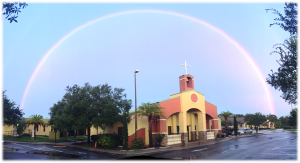 In 1992, Bishop Favalora blessed a new 3,500 square foot worship center dedicated almost entirely to migrant families, Our Lady of Guadalupe in Wimauma. The Mission was established in 1988.
In 1992, Bishop Favalora blessed a new 3,500 square foot worship center dedicated almost entirely to migrant families, Our Lady of Guadalupe in Wimauma. The Mission was established in 1988.
During the 1990s, the Diocese strengthened its Migrant Ministries to meet the needs of migrants moving into the area. The Diocese was sensitive to their cultural needs. Under the leadership of Bishop John Clement Favalora, the Diocese recruited and assigned Spanish-speaking clergy to those areas with the highest concentration of migrant families. Four rural churches enhanced their migrant ministries: St. Clement (Plant City), St. Rita (Dade City), St. Anne (Ruskin) and Our Lady of Guadalupe (Wimauma). They provided Masses and Bible studies in Spanish, social activities to help them feel welcome and social service and referral programs.
On October 15, 2003, three hundred people from all walks of life came together to celebrate a successful, decade-long effort to provide safe, affordable and dignified homes for farmworker families in the strawberry fields of Dover/Plant City. The San Jose Mission is a residential community and education/social services campus for migrant farmworker families. We partner with community groups and Hillsborough County to provide English classes, clothing, and healthcare and educational opportunities to the families who live there.
IMPACT ON THE ELDERLY
Our commitment to providing affordable housing started with a focus on serving the elderly who were most in need of quality, affordable housing. The majority were widows who were living in squalor in retirement. By partnering with the Federal government’s Department of Housing and Urban Development (HUD), we have been able to assist the elderly. The first affordable housing property to be built for seniors located in the five counties of the Diocese of St. Petersburg is called King’s Manor. It was built at Christ the King Parish in Tampa in 1983.
Criteria for selection by HUD included financial need, location, demographics, and “strength of sponsor.” Sponsors had to show they are responsible members of the community, stable and not fly by night. “We’ve been around 2,000 years,” said James Sebesta, director of the diocesan real estate office, in 1997.
The Diocese started with 99 housing units in one facility for the elderly in 1983 and has since grown to 1,019 units in 14 facilities today.
IMPACT ON THE HOMELESS AND DISABLED
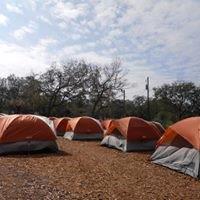 Temporary shelter for the homeless is provided at Pinellas Hope, which was originally called Tent City. In 2007, the Diocese of St. Petersburg set out to respond to an urgent need to assist the homeless population. Bishop Robert Lynch began a temporary housing site on 10 acres of diocesan land. Named “Pinellas Hope,” it quickly grew under his guidance into a comprehensive outreach that provides food, shelter, safety and opportunities to build a dignified life for those most in need in our community. Bishop Lynch once referred to Pinellas Hope as “the miracle on 49th Street” because it was a coming together of the political world (county, city, municipalities) Catholic Charities, as well as Catholic and non-Catholic churches. Nearly 10,000 homeless men and women have been served at Pinellas Hope in the past ten years and 1.5 million meals have been provided. Additionally, apartment buildings with 156 efficiency units have opened at Pinellas Hope to provide permanent housing to individuals, some of whom are veterans.
Temporary shelter for the homeless is provided at Pinellas Hope, which was originally called Tent City. In 2007, the Diocese of St. Petersburg set out to respond to an urgent need to assist the homeless population. Bishop Robert Lynch began a temporary housing site on 10 acres of diocesan land. Named “Pinellas Hope,” it quickly grew under his guidance into a comprehensive outreach that provides food, shelter, safety and opportunities to build a dignified life for those most in need in our community. Bishop Lynch once referred to Pinellas Hope as “the miracle on 49th Street” because it was a coming together of the political world (county, city, municipalities) Catholic Charities, as well as Catholic and non-Catholic churches. Nearly 10,000 homeless men and women have been served at Pinellas Hope in the past ten years and 1.5 million meals have been provided. Additionally, apartment buildings with 156 efficiency units have opened at Pinellas Hope to provide permanent housing to individuals, some of whom are veterans.
In 2005, the Diocese also built Bethany Family Apartments for homeless or low-income families with a disabled family member located in Pasco County and in 2012 the Diocese assumed operations for Benedict Haven in Pinellas County, a home for men who live with severe mental illness.
The Pasco Women’s Shelter, a temporary homeless shelter for women and children, opened in 2013.
IMPACT ON LOW-INCOME FAMILIES
Between 2008 and 2017, the Diocese opened 8 affordable housing properties to serve low-income families on the verge of homelessness. They are able to remain off the streets because we are able to provide affordable housing and/or financial assistance for rent.
IMPACT ON PEOPLE LIVING WITH HIV/AIDS
In the 1980s and 1990s, AIDS was epidemic. The Diocese worked with the Federal Government, and Pinellas and Hillsborough Counties to establish housing for individuals with HIV/AIDS as well as mothers and children with HIV/AIDS.
The Christopher House, which started in 1995, was the first house for people living with HIV/AIDS opened by the Diocese of St. Petersburg. Mercy House, which opened in 1996, serves mothers and their children impacted by HIV/AIDS.
IMPACT ON PEOPLE FACING A FINANCIAL CRISIS
In 2006, Catholic Charities started the Pathways Direct Aid program that provides direct financial assistance to people facing a crisis, such as a loss of employment or illness. In that time, more than 2,000 people have received financial assistance for rent, medical bills, electricity, etc. totaling more than $1.6 million dollars. When you include the financial assistance provided by St. Vincent de Paul Society in our parishes over the past 50 years, the amount of direct aid provided to people in need over the past 50 years has exceeded $50 million dollars.
IMPACT ON REFUGEES
The Diocese has been assisting refugees since its early years. Catholic Charities and local parishes assisted with resettling Vietnamese refugees starting in the mid-1970s. Catholic families and parishes were asked to sponsor families and orphans were adopted through Catholic Charities. Catholic Charities has helped to welcome into our community more than 16,000 refugees. These refugees, who left their countries with no belongings, have received temporary housing, job assistance, language classes and other assimilation services. The refugees have arrived here from countries that have faced ongoing tragedies, such as Bosnia, Cuba and Syria.
IMPACT ON EDUCATION
The Diocese has a vital role in the academic and Christian development of students in West Central Florida. Whether students are enrolled in parish-based religious education or a Catholic school, the mission is to provide a faith-filled community where students can grow spiritually, academically, and socially.
There are 48 Catholic Schools and Early Childhood Centers in the Diocese of St. Petersburg that provide Catholic education to more than 12,000 students in the counties of Pinellas, Hillsborough, Pasco, Hernando, and Citrus. Since 1968, we have had more than 35,000 students graduate from Catholic high schools in the five counties of the Diocese of St. Petersburg.
IMPACT ON THOSE SEEKING ADOPTION SERVICES
Adoption Services has served the adoption triad: birth parents, children, and adoptive families since 1964 through a coordinated set of services designed to identify infants and young children who are at risk of abuse, neglect, or abandonment by virtue of their parents not being ready, willing, or capable of parenting them, to find suitable, permanent homes for those children, and to provide supportive services to triad members such as search services for those who mutually desire to reunify with birth parents or adoptees. Currently Adoption Services, Diocese of St. Petersburg serves 4 dioceses across 25 counties.
IMPACT ON THOSE SEEKING PREGNANCY SERVICES AND POST ABORTION HEALING The Foundations of Life Pregnancy Center Programs have served the Diocese since 1993 and are dedicated to addressing the needs of individuals facing the challenges of pregnancy and parenting and making positive life choices. The program reflects the Church’s love for the lives of the unborn as well as for the health, welfare and development of parents and their babies. Foundations of Life, formerly Pregnancy Plus Medical, has grown from one center to 5 centers and currently provides help and hope to over 2,400 clients with almost 7,000 visits each year. Over 10,000 babies have been saved.
Project Rachel, post Abortion Healing program, is dedicated to promoting the healing of the wound of abortion in individuals.
IMPACT ON THOSE SEEKING MEDICAL ASSISTANCE
Since 2000, Catholic Charities has provided medical care to people without insurance, many considered the working poor. We operate a medical bus that travels to high-need areas and offers medical care. Catholic Charities also operates three free medical clinics, located in Dade City, Wimauma and Dover. Since 2000, we have served 17,000 individuals in need of life-saving care.
Additionally, there are six Catholic hospitals overseen by the Bishop of our Diocese that were started by the Allegany Franciscans: St. Anthony’s Hospital, St. Joseph’s Hospital, St. Joseph’s Women’s Hospital St. Joseph’s Hospital-North, St. Joseph’s Hospital- South, and St. Joseph’s Children’s Hospital.
FACTS ABOUT THE PRESENT AND THE PAST
The Catholic Church in West Central Florida includes 74 parishes and seven missions in five counties: Citrus, Hernando, Pasco, Hillsborough and Pinellas. There are 125,000 registered Catholic households, representing over 470,000 Catholics. Within the Diocese of St. Petersburg, there are also 27 elementary schools, 12 early childhood centers, two special needs schools, seven high schools, a Catholic university and three campus ministry programs, six Catholic hospitals, seven health care and medical centers, 10 homes for the chronically ill, 67 centers for social services/assistance, and four retreat centers.
Because of the growing number of Catholics in Florida, Pope Paul VI signed a Papal Decree establishing the Diocese of St. Petersburg on March 2, 1968. The area was formerly part of the Dioceses of St. Augustine and Miami. A separate territory was needed to meet the pastoral needs of the growing Church. A new diocese in St. Petersburg would help unify priests, personnel and policy to serve the rapidly increasing population within the area.
On June 17, 1968, a Mass was celebrated at the Cathedral of St. Jude the Apostle to establish the Diocese of St. Petersburg and to install the area’s first Bishop, Most Reverend Charles B. McLaughlin.
At the time of its establishment, the Catholic population throughout the Diocese of St. Petersburg was approximately 200,000 and the region consisted of 11 counties. In 1984, the six southern counties of the Diocese of St. Petersburg became part of the Diocese of Venice.
The Catholic faith has been a part of West Central Florida since Spanish missionaries arrived in the 16th century. With great courage, the missionaries risked and sometimes lost their lives for the sake of the Kingdom of God. They planted the seeds of the Catholic faith and those seeds scattered from place to place and the faith spread. These missionaries adhered to the great commission to “go and make disciples of all nations” (Matthew 28:19).
In these last 50 years, the Diocese of St. Petersburg has realized many blessings because of the faith, sacrifice, generosity and spirit of the people who make up this vibrant and faith-filled community.
Since the Diocese was founded, nearly all of the 51 parishes established before 1968 have undergone renovations, expansions, and/or additions to accommodate growth and the need for larger worship spaces and new parish halls.
Additionally, 23 parishes have been established since 1968. The growth of parishes has mirrored the growth in the Tampa Bay region. Where pine trees, palmetto scrub, and swamps once stood, elegant houses of worship now grace the landscape. When parishes were established, the clergy and the community needed determination and faith to survive those early years. Masses were often celebrated in homes, restaurants, hotels and schools. For example, the Largo Recreation Center served as a spiritual home for St. Catherine of Siena Parish before they constructed and dedicated a church building in 1978. There were many challenges along the way but parishes overcame the difficulties as a community. For example, St. Elizabeth Ann Seton in Citrus Springs was established in 1972. They soon discovered the property had sand drainage problems and cars would get stuck going in and out of the church. Eventually, the parking lot was paved and the project was done completely by volunteers.
Five missions have also been established in the last 50 years to meet the needs of ethnic communities. These missions are the Mercy of God Polish Mission in St. Petersburg (1991), Holy Martyrs of Vietnam Mission, Largo (1991), St. Joseph Vietnamese Mission, Tampa (1991), Immaculate Conception Haitian Mission, Tampa (2004), Our Lady of Guadalupe Migrant Worker Mission, Wimauma (1988). St. Casimir Lithuanian Mission (1963) and the Catholic Student Center at U.S.F. (1966) already existed prior to the establishment of the Diocese.
Nine Catholic schools have opened in the last 50 years. Two schools opened in Pasco County: Bishop Larkin Catholic School (1989) and Bishop McLaughlin Catholic High School (2003). Pope John Paul II School (originally called Central Catholic School of Citrus County) opened in Citrus County (1985). In Pinellas County, three schools have opened: Espiritu Santo in Safety Harbor (2001), Guardian Angels in Clearwater (1992) and Morning Star in Pinellas Park (1969). Two new schools have opened in Hillsborough County: St. Stephen Catholic School in Riverview (2001) and in 2013, construction of a new Catholic elementary school in northwest Hillsborough County was completed. The school was named after the beloved Mother Teresa of Calcutta who was canonized in 2016. Notre Dame Interparochial School (originally named St. Theresa) opened in Hernando County in 1985.
Twelve early childhood centers have also been established since 1968 that still serve young families who seek a faith-based setting for their pre-school children.
In 2007, the Bethany Center, a diocesan retreat and conference center, opened on two beautiful lakes in northern Hillsborough County. The facility’s modern amenities are immersed within a pristine natural setting. There are six cottages, each with 9 guest rooms, plus a gathering room for fellowship. The Bethany Center also has plenty of dedicated space for meetings, conferences, banquets and fellowship. Buildings were designed with floor to ceiling windows and large verandas overlooking the lakes.
In 2013, expansion and extensive renovations were completed on the Cathedral of St. Jude the Apostle. The project expanded the church from 25,713 to 33,546 square feet to accommodate larger celebrations in the Diocese’s “Mother Church.” The renovation also included wider aisles with alcoves for shrines, new pews, floors, a new roof and a baptismal font designed for immersion.
LOOKING TO THE FUTURE
The Diocese of St. Petersburg represents many cultural and ethnic groups, believers of all ages, income levels and education. In fact, Mass is celebrated in 12 languages. This diversity is a strength that builds up the fabric of our Church as the unique contributions of our cultural and ethnic groups are respected and celebrated.
During its 50-year history, our leaders have sought to build bridges with people of all faith traditions to serve people in joyous times and in times of tragedy and sorrow. Under the current leadership of Bishop Gregory Parkes, the Diocese has seen a renewed commitment to reach out to those on the peripheries of society and among the most vulnerable. Therefore, we can truly remember the past with gratitude, celebrate the present with joy and look to the future with hope!

